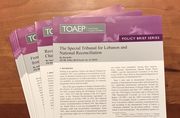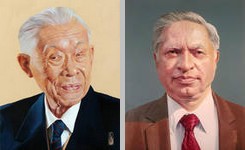Element:
ICTY
About the prohibited purposes, the Mucić et al. Trial Chamber stated:
"Another critical element of the offence of torture is the presence of a prohibited purpose. As previously stated, the list of such prohibited purposes in the Torture Convention expands upon those enumerated in the Declaration on Torture by adding 'discrimination of any kind'. The use of the words 'for such purposes' in the customary definition of torture, indicate that the various listed purposes do not constitute an exhaustive list, and should be regarded as merely representative. Further, there is no requirement that the conduct must be solely perpetrated for a prohibited purpose. Thus, in order for this requirement to be met, the prohibited purpose must simply be part of the motivation behind the conduct and need not be the predominating or sole purpose."[1]
The Mucić et al. ("Čelebići") Trial Chamber also considered that:
"A fundamental distinction regarding the purpose for which torture is inflicted is that between a 'prohibited purpose' and one which is purely private. The rationale behind this distinction is that the prohibition on torture is not concerned with private conduct, which is ordinarily sanctioned under national law. In particular, rape and other sexual assaults have often been labelled as 'private', thus precluding them from being punished under national or international law. However, such conduct could meet the purposive requirements of torture as, during armed conflicts, the purposive elements of intimidation, coercion, punishment or discrimination can often be integral components of behaviour, thus bringing the relevant conduct within the definition. Accordingly,'[o]nly in exceptional cases should it therefore be possible to conclude that the infliction of severe pain or suffering by a public official would not constitute torture ... on the ground that he acted for purely private reasons.'"[2]
The Mucić et al. Trial Chamber added:
"As noted above, the Defence argues that an act can only constitute torture if it is committed for a limited set of purposes, enumerated in the Commentary to article 147 of the Fourth Geneva Convention. This proposition does not reflect the position at customary law as discussed above, which clearly envisages prohibited purposes additional to those suggested by the Commentary."[3]
As to the sort of purposes that satisfy this requirement, the Mucić et al. Trial Chamber opined that:
"The purpose of these rapes was to intimidate, coerce and punish Ms. Antic. Further, at least with respect to the first rape, Delic's purpose was to obtain information from Ms. Antic, as it was committed in the context of:
"interrogation. In addition, the violence suffered by Ms. Antic in the form of rape, was inflicted upon her by Delic because she is a woman. As discussed above, this represents a form of discrimination which constitutes a prohibited purpose for the offence of torture."[4]
According to the Trial Chamber in Mucić et al. ("Čelebići")
"Nedeljko Draganić himself testified that on one occasion towards the end of June or beginning of July 1992, while he was confined in the Čelebići prison-camp, Esad Landžo and three other guards took him to another hangar, where they tied his hands to a beam in the ceiling and started hitting him with wooden planks and rifle butts, while asking him disclose where a rifle, which they believed him to own, was hidden, and during which he fainted two or three times. Thereafter, he was beaten almost every day by Esad Landžo, usually with a baseball bat and he was also forced, along with other detainees, to drink urine from the area where they were taken to urinate. On another occasion, Mr. Draganić testified that Esad Landžo took him to the same building and made him sit on the floor, against the wall, with his legs close together. Mr. Landžo then poured some gasoline on the lower part of his trousers and set them alight. As a consequence, his legs were badly burnt and, for lack of subsequent medical attention, the blisters caused by the burning became septic, requiring him to be taken to the so-called infirmary in Building 22 for treatment about a week later[56]... All of these abovementioned forms of mistreatment clearly caused serious mental and physical suffering to the victim and there is, therefore, enough reliable evidence available on the record to substantiate the charges of wilfully causing great suffering or serious injury to body or health, and the cruel treatment of, Nedeljko Draganić, contained in counts 36 and 37 of the Indictment."[5]
The Kvočka Trial Chamber, in addressing the primacy of the prohibited purpose concurred with Čelebići that:
"the prohibited purpose need be neither the sole nor the main purpose of inflicting the severe pain or suffering."[6]
The Furundžija Appeals Chamber agreed with the Trial Chamber's articulation of the purpose element, noting that:
"[I]t must aim at obtaining information, or a confession, or at punishing, intimidating, humiliating or coercing the victim or a third person, or at discriminating, on any ground against the victim or a third person"[7]
The Furundžija Trial Chamber proposed an example of a "newer purpose"
"the Trial Chamber considers that among the possible purposes of torture one must also include that of humiliating the victim. This proposition is warranted by the general spirit of international humanitarian law: the primary purpose of this body of law is to safeguard human dignity. The proposition is also supported by some general provisions of such important international treaties as the Geneva Conventions and Additional Protocols, which consistently aim at protecting persons not taking part, or no longer taking part, in the hostilities from 'outrages upon personal dignity'. The notion of humiliation is, in any event close to the notion of intimidation, which is explicitly referred to in the Torture Convention's definition of torture."[8]
The Kunarac Trial Chamber stated:
"On the other hand, three elements remain contentious:
"(i) The list of purposes the pursuit of which could be regarded as illegitimate and coming within the realm of the definition of torture [...]"[9]
The Chamber then concluded:
"The Trial Chamber is satisfied that the following purposes have become part of customary international law: (a) obtaining information or a confession, (b) punishing, intimidating or coercing the victim or a third person, (c) discriminating, on any ground, against the victim or a third person. There are some doubts as to whether other purposes have come to be recognised under customary international law." "[10]
"The act or omission must aim at obtaining information or a confession, or at punishing, intimidating or coercing the victim or a third person, or at discriminating, on any ground, against the victim or a third person."[11]
The Trial Chamber in the Haradinaj and al. retrial held that:
"Torture [...] aims, through the infliction of severe mental or physical pain, to attain a certain result or purpose. This includes, albeit not exhaustively, the purpose to obtain information or a confession, to punish, intimidate or coerce the victim or a third person, or to discriminate, on any ground, against the victim or a third person. In the absence of these purposes or goals, even very severe infliction of pain would not be classified as torture."[12]
ICTR
By contrast, the Akayesu Trial Chamber adopted a more restrictive approach:
"The Chamber defines the essential elements of torture as :
(i) The perpetrator must intentionally inflict severe physical or mental pain or suffering upon the victim for one or more of the following purposes:
(a) to obtain information or a confession from the victim or a third person;
(b) to punish the victim or a third person for an act committed or suspected of having been committed by either of them;
(c) for the purpose of intimidating or coercing the victim or the third person;
(d) for any reason based on discrimination of any kind.
"(ii) The perpetrator was himself an official, or acted at the instigation of, or with the consent or acquiescence of, an official or person acting in an official capacity."[13]
According to the Trial Chamber in Ntagerura et al.,
"The Chamber has found that soldiers under Imanishimwe's effective control and in his presence severely beat Witness MG and another detainee and hammered a long nail into the foot of one detainee, removed the nail, and hammered it into the foot of another detainee while questioning them whether they were members of the RPF and accusing them of collaborating with the enemy. [...]"[]"[]
"On the basis of the foregoing, the Chamber finds that, in mistreating Witness MG and the other three detainees, the soldiers were acting intentionally and with the aim of obtaining information or confessions from the detainees or punishing them. Additionally, the Chamber finds that the severe beating and mistreatment with the long nail amounted to infliction of severe physical pain. Consequently, the Chamber finds beyond a reasonable doubt that this mistreatment constituted torture within the scope of Article 4(a) of the Statute."[14]
Footnotes:
[1] ICTY, Mucić et al. ("Čelebići") Trial Judgment, 16 November 1998, para. 470.
[2] ICTY, Mucić et al. Trial Judgment, 16 November 1998, para. 471.
[3] ICTY, Mucić et al. ("Čelebići") Trial Judgment, 16 November 1998, para. 472.
[4] ICTY, Mucić et al. Trial Judgment, 16 November 1998, para. 963.
[5] ICTY, Mucić et al. ("Čelebići") Trial Judgment, 16 November 1998, para. 1018.
[6] ICTY, Kvočka Trial Judgment, 2 November 2001, para. 153.
[7] ICTY, Furundžija Appeal Judgment, 21 July 2000, para. 111, See also ICTY, Furundžija Trial Judgment, 10 December 1998, para. 162.
[8] ICTY, Furundžija Trial Judgment, 10 December 1998, para. 162. (footnotes omitted).
[9] ICTY, Kunarac et al. Trial Judgment, 22 February 2001, para. 484.
[10] ICTY, Kunarac et al. Trial Judgment, 22 February 2001, para. 485.
[11] ICTY, Kunarac et al. Trial Judgment, 22 February 2001, para. 497.
[12] ICTY, Haradinaj et al. Trial Judgment , 29 November 2012, para. 418.
[13] ICTR, Akayesu Trial Judgment, 2 September 1998, para. 594.
[14] ICTR, Ntagerura et al. Trial Judgment 25 February 2004, para. 796-797.







